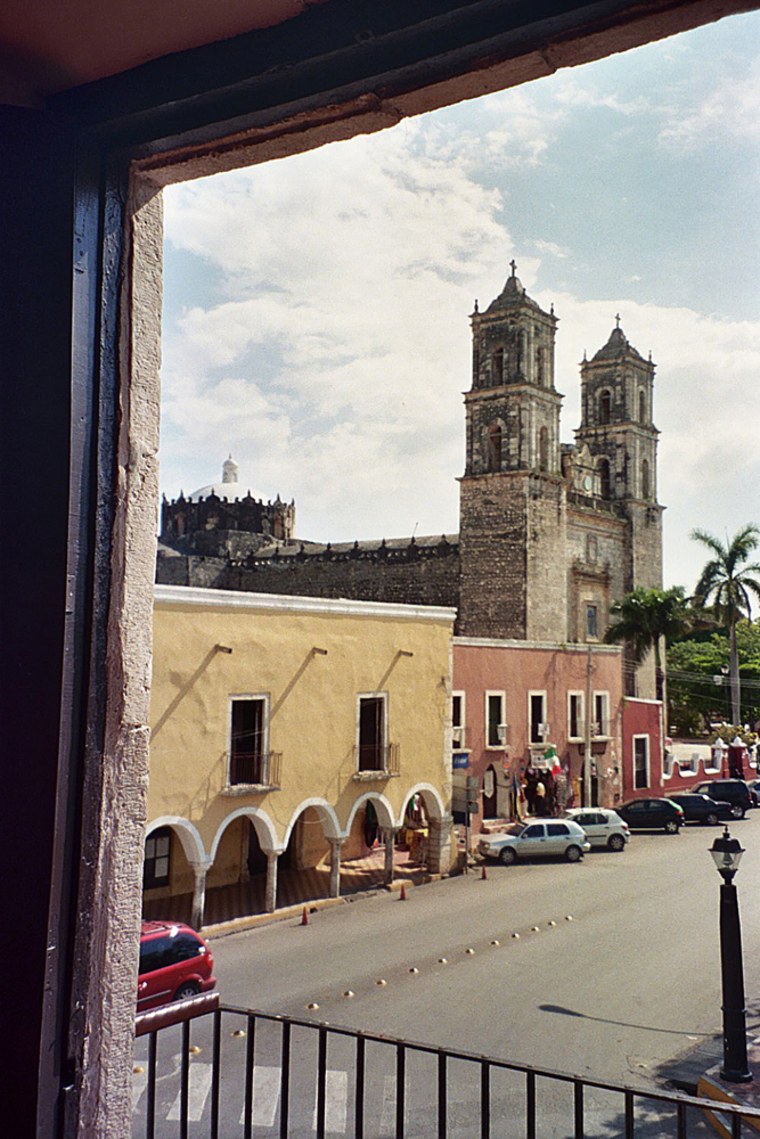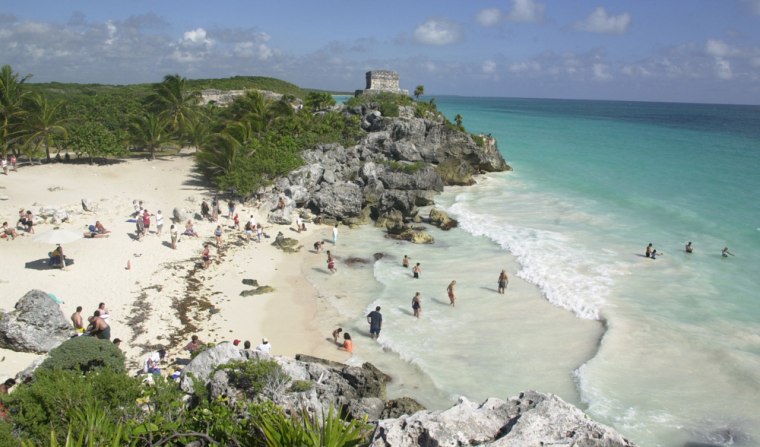In the late afternoon breeze, turquoise waves are crashing against the tiny gray rocky point, palms fronds are swaying over it and a pelican keeps swooping over the crescent of snow-white beach like a diner who can't decide what to pick from tonight's menu.
I lazily sway in the breeze too, deep in my hammock under a beach "umbrella" made of thatched palm fronds in a small, eco-friendly hotel, just south of the mesmerizing Maya ruins of Tulum, on Mexico's Caribbean coast.
Sunset-tinged storm clouds are dumping an early summer downpour a few miles inland, but nothing frazzles my corner of paradise - except that I keep wondering whether Panchita would approve.
Panchita Kama is the minute Maya old lady who sold me two hand-embroidered handkerchiefs for $1 yesterday at the archaeological park of Chichen Itza, her people's most important city a thousand years ago.
Traveling the 120 miles east from the venerable Maya pyramids, through pastel colonial towns and jungle hut settlements, to Cancun's Vegas-like hotel zone, I can't help but contemplate the contrasts. Tourists and locals, ancient and modern, luxury and poverty. It's like going from Mexico's glorious past through its hard-living present to an outward-looking future. And wondering what that future is going to do to the other two.
Cancun has served the purpose for which it was created: It brings $6 billion in revenue a year to Mexico, and provides some of the highest-paying jobs in Mexico. Guests at luxury resorts in Cancun may think nothing of blowing $500 a day on vacation, but tourism workers feel fortunate to have coveted jobs that pay $400 a month. Wages are so good by local standards that there has been a massive influx of Mexicans who have migrated to the tourist resort looking for jobs.
"You won't find a town without somebody working either in Cancun or in the U.S.," said Bianet Castellanos, a professor at the University of Minnesota who studies the effect of Cancun's tourism economy on Maya communities.
Castellanos said that income means their families back in the countryside can afford to eat meat with their corn. After all, this is a country where thousands of people marched in early February to protest an increase in the price of tortillas.
But most of the cash that tourists bring every year to the coast of all-inclusive resorts stays there, largely in the pockets of the corporations that own them.
"The world tourists see isn't the world those who support it can ever occupy," said Dominique Rissolo, an archaeologist who's worked with the Maya for 15 years.
Thankfully, as mysteriously captivating as the Maya ruins and as beautiful as the beaches are, I found it impossible to miss the real country everywhere I went.
There was the skinny, bare-chested man carrying a bulging bundle of firewood tied to his forehead who emerged inexplicably from the jungle along a stretch of the cuota, the toll-road crossing the Yucatan peninsula. No settlement was visible and the only other sign of activity were the swarms of butterflies in the 90-degree heat.
Along the parallel, free road, I saw boys and dads kicking a ball made of rags in spirited soccer matches while moms and sisters watched on from their huts in their immaculate, embroidered huipil dresses.
In the vast square in front of Valladolid's Convento de San Bernardino, a sprawling 1550s monastery at the heart of the joyous colonial city, a group of men watched a soccer match on a slightly blurry TV perched on a makeshift stand.
Some 25 miles away, hordes of tourists and souvenir-sellers are all over the stunning complex of Chichen Itza, from the central pyramid, El Castillo, with its 91-step stairways to heaven, to the sacred cenote, a military green, large natural well guarded by iguanas. Carved along the temples and platforms are jaguars, serpents, menacing skulls and warriors.

On a Sunday, when admission to archaeological sites is free, local residents happily splash in the sliver of beach underneath the 40-foot cliffs that support the most photographed ruin in the Caribbean - the 15th century Castillo in Tulum.
The site and the small town of the same name are an 80-mile drive south of Cancun on a highway not unlike that connecting the Florida Keys. I drove past scrubby jungle, innumerable gated entrances to resorts, several commercialized lagoons and cave-diving parks, and the booming city of Playa del Carmen, whose shopping district with annoying hawkers makes it look too much like the cruise excursion spot it is.
The road that connects Cancun and Tulum is being widened from two lanes to four, and that may accelerate development pressures on Tulum. But for now, the bland touristy look disappears just south of the Tulum ruins, where the road sneaks past mangroves onto the beach and groups of candlelit, mosquito-netted palapas (thatched huts) inhabited by tourists and locals alike replace air-conditioned, pool-surrounded resorts.
"This is still for us," said the waiter at Zamas, my hotel, as he serves me dinner - a whole boquinete fish in tangy achiote sauce - gesturing toward the dark stretch of beach and the sea from which that snapper has been fished a few hours ago.
The next morning, I take to the water in a blue and yellow striped dinghy with two local divers, a family from New York and a couple from Texas.
Slideshow 11 photos
Marvelous Mexico
We swim along the reef, watching turtles, grumpy groupers and round, black fish with fluorescent blue spots as they scuttle away among bright purple fans and yellow "brain" corals.
No more than 200 yards away, the Tulum ruins preside over the gray cliffs, their squat platforms, snake-shaped columns and "diving god" friezes as majestic and real as they must have appeared to the Spanish conquistadors who first sailed into the trading center, still occupied by the Maya, in 1518.
That night, I wonder about change and the future of this blissful corner of sand, jungle and ancient civilization as I fall asleep under rustling palm fronds, a catcalling bird and a couple of watchful lizards on the walls of my palapa.
I can only hope that there's a way tourist dollars can give a better future to the people I've met without changing their ancestral land into an artificial strip of anonymous, gated luxury.
It's my last morning in the Yucatan peninsula and I'm risking missing my flight if I stay longer on the beach, watching fishermen take the orders the chef gestures to them as they speed past the rocky point.
But I find it impossible to tear myself away from the gently undulating hammock a few feet from the turquoise surf.
In this, at least, I hope to have Panchita's blessing.

